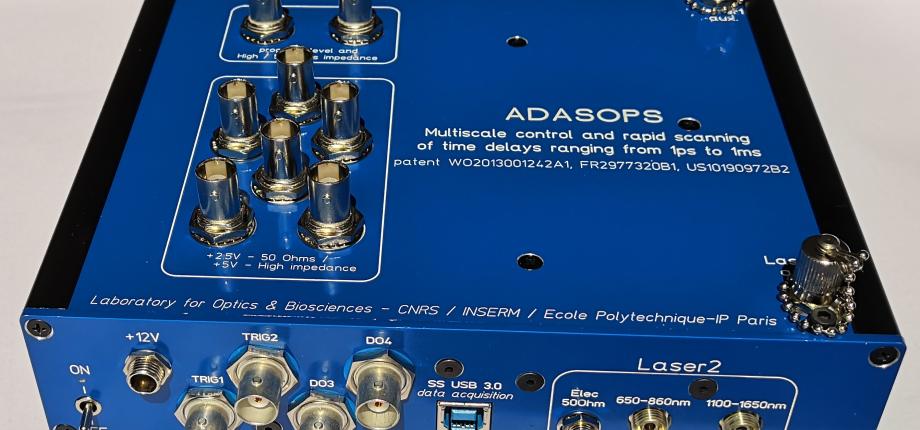Multi-scale femto-millisecond transient absorption spectroscopy platform.

Researchers and engineers in the “Dynamique Interne des Biomolécules” (DynaBio) teamr of the Laboratoire d'Optique et Biosciences (LOB) are specialists in the study of fundamental biological processes at the molecular level, using ultrafast pump-probe optical spectroscopy techniques based on femtosecond lasers. Using the ADASOPS (Arbitrary-Detuning ASynchronous Optical Sampling) technique, they have developed a new multiscale time-resolved spectroscopy method for measuring dynamics in the femtosecond to millisecond range. The ADASOPS technique enables precise control of the delay between two pulses from two different laser sources.
As part of ULTRAFAST-LUMA, LOB has decided to open a multi-scale ultrafast spectroscopy platform, with access to 2 pump-probe experiments using two fs Ti:Sa kHz laser sources and the ADASOPS technique:
-UV-Visible (femtosecond) pump-probe multiscale in the broad spectral band covering the Visible range (400 nm - 750 nm) with kHz detection,
-UV-Visible (femtosecond)-probe multi-scale pump in wide spectral band covering the mid-infrared range from 1300 cm-1 to 2400 cm-1 with kHz detection.
2 other experiments, coupling a Ti:Sa kHz source and a high repetition rate (250kHz) Ytterbium (Yb) laser source (acquisition of a source as part of the PEPR LUMA program), are currently under development and will open in 2025.
In addition, visitors will have access to the biochemistry laboratory for sample preparation and to various cells for sample renewal and temperature control. As the purpose of the reception is to obtain spectra of transient species and their characteristic lifetimes, data processing support will also be available.
In short, to probe the sub-picosecond to millisecond dynamics that are crucial for most complex photoactive systems (photo-catalysis, solar cells, photosynthesis, bio-imaging, photoactivatable proteins), the LOB's multiscale platform will eventually provide continuous femtosecond to millisecond coverage of the UV-Vis-NIR (220 nm - 2000 nm) and MIR (4-10 µm) spectral range.
Examples of scientific and technical publications and patents:
Home :
250 days
New equipment acquired and opened for hosting as part of ULTRAFAST-LUMA :
UV-Vis-NIR
Laser pulses:
Probe 500 Hz, 100 fs, white light continuum (370 - 750 nm)
Pump 500 Hz, 100 fs, 4 µJ at 400 nm and 2 µJ 520-700 nm
S/N: 1%RMS
Sample environment :
Temperature 10 - 80°C
Lissajoux displacement and peristaltic pump for sample renewal at 1 kHz, can be coupled with stationary irradiation.
Detection :
Multi-scale pump-probe spectroscopy (ADASOPS) with pump-probe delay controlled to within 500 fs RMS up to a maximum delay of 1 ms. Spectral resolution of 1 nm.
Fields of application :
Multiscale electronic spectroscopy
Future developments :
Pump tunability extended to the UV-visible range after OPA acquisition
Probe tunability under development from 220 nm - 2000 nm
Probe repetition rate increased to 125 kHz under development with Ytterbium laser
MIR
Laser pulses:
Probe 1 kHz, 100 fs, 1 µJ at 5 µm, tunable between 1200 and 2400 cm-1
Pump 500 Hz, 100 fs, 1 µJ at 400 nm
Stability: 1%RMS
Sample environment :
Ambient temperature
Peristaltic pump for sample renewal at 1 kHz
Detection :
Multi-scale pump-probe spectroscopy (ADASOPS) with pump-probe delay controlled to within 500 fs RMS to a maximum delay of 1 ms. Spectral resolution of 1 cm-1.
Applications :
Multiscale vibrational spectroscopy
Future developments :
Pump tunability extended to the UV-visible range after OPA acquisition.
Probe repetition rate increased to 125 kHz after Ytterbium laser acquisition.
Members :
Laura Antonucci, Adeline Bonvalet, Pascale Changenet, Manuel Joffre, Michel Sliwa, Xavier Solinas, Marten Vos
Contact : | |
|---|---|
Scientific Responsible: Michel Sliwa michel.sliwa@polytechnique.edu | Technique Responsible: laura.antonucci@polytechnique.edu |



